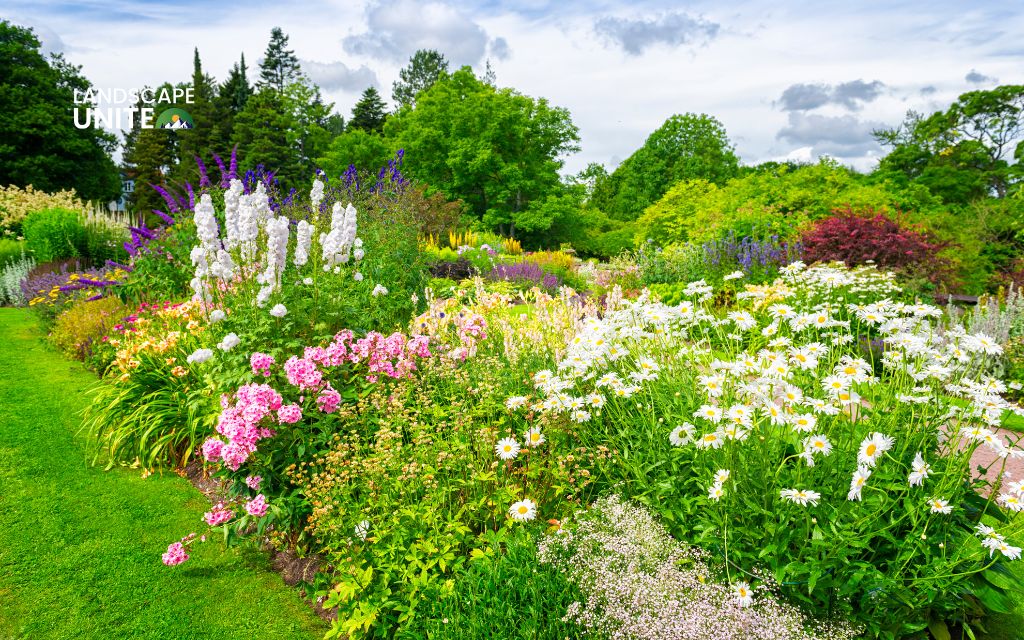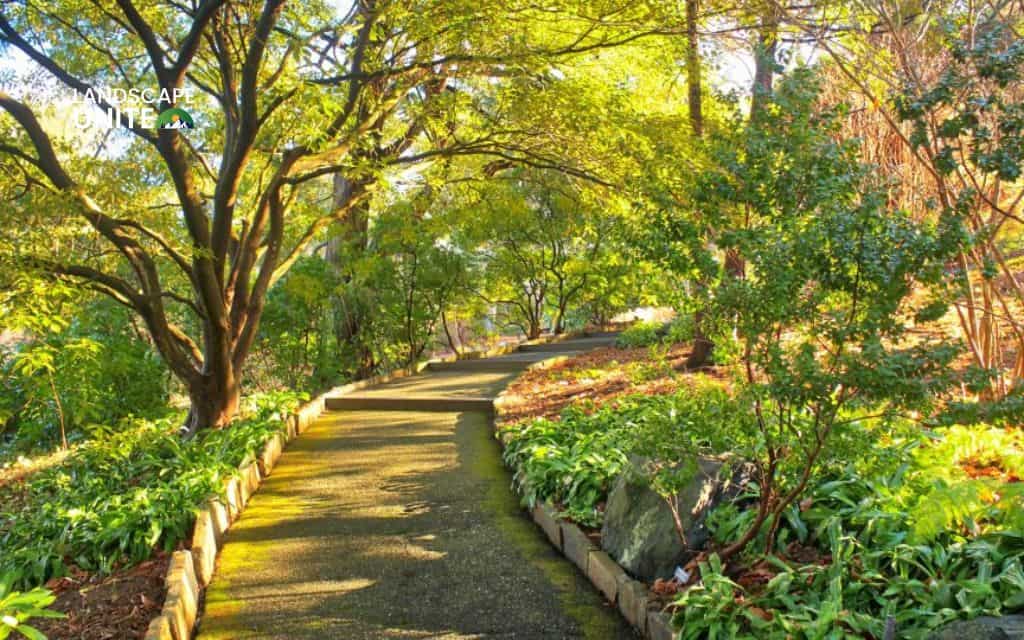Unlike wooden beds that rot or metal edges that rust, stone offers a timeless solution that enhances your landscape for decades. From rustic fieldstone borders that complement cottage gardens to sleek cut stone designs perfect for modern landscapes, raised rock flower beds adapt to any aesthetic vision.
In this guide, you’ll learn how to create raised rock flower beds, plus explore 14 inspiring ideas for every yard style and budget.
We’ll cover everything from selecting the right stone types and plant and long-term maintenance requirements, giving you the complete knowledge needed to create a stunning garden feature that stands the test of time.
Pros and cons of raised rock flower beds
Before investing into raised rock flower beds, understanding both advantages and limitations helps you make an informed decision that aligns with your goals, budget, and preferences.
Pros
Durability
Natural rock lasts decades without rotting or warping. Unlike wood that deteriorates within 5-10 years or plastic that becomes brittle, properly installed stone beds can last 50 years or more with minimal maintenance. This longevity makes them cost-effective over time despite higher initial investment.
Aesthetic appeal
Stone complements both traditional and modern gardens with remarkable versatility. The natural texture and color variations create visual interest that enhances property value and curb appeal. Whether you choose weathered fieldstone for rustic charm or cut limestone for contemporary elegance, rock adapts to your design vision.
Low maintenance
Once installed, raised rock flower beds require minimal upkeep. There’s no painting, staining, or treating needed. The solid structure resists decay, pest damage, and weather-related deterioration that plagues other materials.
Excellent drainage
The gaps between stones allow excess water to escape freely, preventing waterlogging. This makes rock beds valuable in rainy regions or areas with heavy clay soil where drainage is a persistent challenge.
Sustainability
Natural stone is an eco-friendly, reusable material that doesn’t require chemical treatments. When sourced locally, it reduces transportation emissions. Stone can be relocated and repurposed indefinitely without generating waste.

Cons
Higher upfront cost
Stone materials typically cost more than wood or metal alternatives. Depending on your region and stone type, expect to pay $8-$25 per square foot for materials, compared to $3-$8 for treated wood. However, this cost should be weighed against decades of use without replacement.
Labor-intensive installation
Heavy materials require significant physical effort or professional help. Large stones can weigh 50-100 pounds each, making installation challenging for solo builders or those with physical limitations. This may add $15-$40 per hour in labor costs if you hire help.
Limited flexibility
Once built, raised rock flower beds are harder to move or resize compared to modular or lightweight alternatives. Relocating a stone bed requires dismantling and rebuilding, which discourages experimentation with garden layout once construction is complete.
Temperature fluctuation
Rocks absorb and radiate heat more than other materials, which can affect plants. In summer, stones heat up significantly, stressing plant roots near the bed edges. This requires careful plant selection and mulching strategies in hot climates.
Choosing the right rocks for your raised bed
Selecting appropriate stone determines both the visual impact and structural integrity of your raised rock flower beds. Different rock types offer distinct advantages depending on your design goals, budget, and regional availability.
Natural stone
Natural fieldstone, flagstone, limestone, and sandstone provide a classic look that’s perfect for traditional or rustic gardens. These stones feature irregular shapes and varied textures that create authentic, organic appeal.
Natural stone typically costs $150 – $400 per ton, with prices varying by region and stone type.
River rock or rounded pebbles
Smooth, water-worn stones create a polished appearance ideal for modern or zen-style landscapes. These rounded rocks lack sharp edges, making them comfortable to brush against and safer for households with children.
River rock works best for decorative edging or mixed-media beds where you want contrast against angular elements. The smooth surfaces reflect light differently than rough stone, adding visual dimension.
Available in sizes from small pebbles to large boulders, river rock typically costs $80 – $200 per ton depending on size and color selection.
Retaining wall blocks or cut stone
Uniform, cut blocks offer the easiest stacking and most consistent appearance for formal, structured raised beds.
These manufactured or cut stones feature flat surfaces and right angles that simplify construction, making them excellent choices for builders without masonry experience. The uniform dimensions ensure stable walls without extensive fitting or adjustment.
Cut stone and retaining blocks cost $3 – $15 per block or $200 – $600 per ton, depending on stone type and finish quality.
Recycled or local rocks
Using recycled stone or rocks naturally present on your property provides a budget-friendly and sustainable option. Local stones reduce transportation costs and environmental impact.
Just ensure rocks are structurally sound without excessive flaking or crumbling. Even when purchasing recycled stone, you’ll typically pay 30-50% less than new materials.
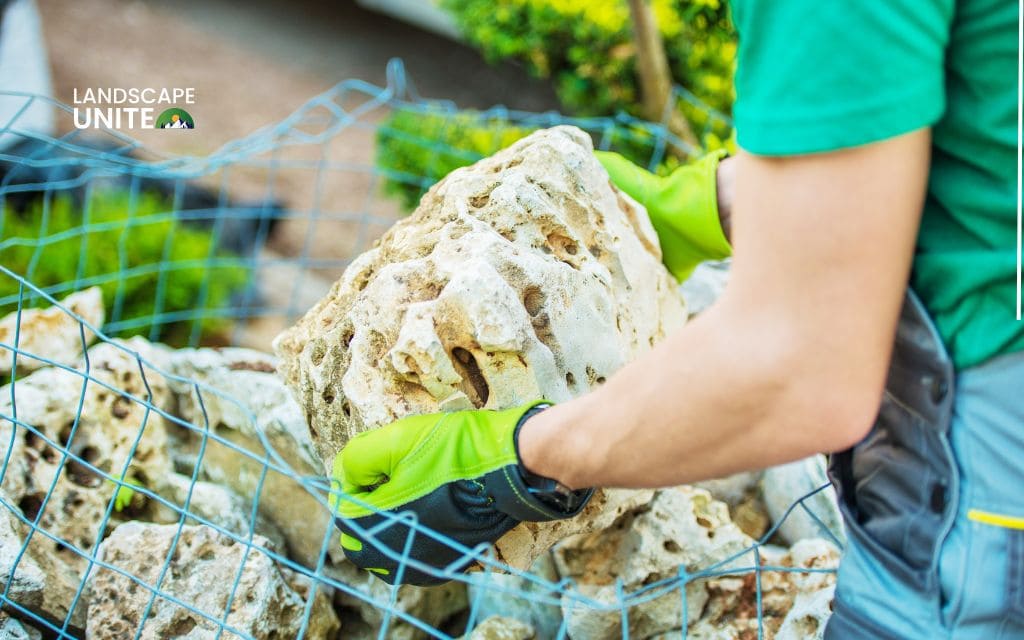
Best flowers and plants for raised rock beds
Sun-loving plants
Raised beds in full sun locations (6+ hours direct sunlight daily) thrive with heat-tolerant perennials that appreciate excellent drainage.
- Lavender
- Coneflowers
- Black-eyed
- Susan
- Salvia
- Coreopsis
These plants handle the warmer soil temperatures and increased heat reflection from surrounding stones.
Shade-tolerant plants
For raised rock flower beds receiving partial to full shade (less than 4 hours direct sun), focus on plants that appreciate consistent moisture and cooler conditions.
- Hostas
- Ferns including Lady Fern and Japanese Painted Fern
- Astilbes
- Coral bells
In shaded locations, monitor moisture carefully as stone beds can dry faster than ground-level plantings.
Drought-tolerant choices
For raised rock flower beds in arid climates or low-water landscapes, select plants that thrive with minimal irrigation.
- Sedum includes varieties from creeping groundcovers to upright forms.
- Agave
- Ice plant
- Yarrow
- Gaillardia
These plants capitalize on the superior drainage raised rock flower beds provide.
14 raised rock flower bed ideas for inspiration
These design concepts demonstrate the versatility of raised rock flower beds across different garden styles, spaces, and budgets. Each idea can be adapted to your specific property conditions and personal aesthetic preferences.
Rustic fieldstone garden
Natural, irregular fieldstone creates a timeless cottage look that appears as though it’s been part of your landscape for generations. Stack weathered stones in varied sizes without mortar, allowing plants to grow between crevices for a naturalized appearance.
This design works perfectly for wildflowers and native plants that complement the organic stone placement. The rough texture and earth-tone colors blend with informal garden settings.

Modern minimalist stone bed
Use precisely cut limestone, slate, or granite for clean, straight lines that complement contemporary architecture. Stack uniform blocks in geometric patterns with tight joints for sleek visual impact.
Pair these structured beds with ornamental grasses like Karl Foerster Feather Reed Grass and architectural succulents such as Hens-and-Chicks or Blue Chalk Sticks. The contrast between orderly stone and flowing plant forms creates striking modern appeal.
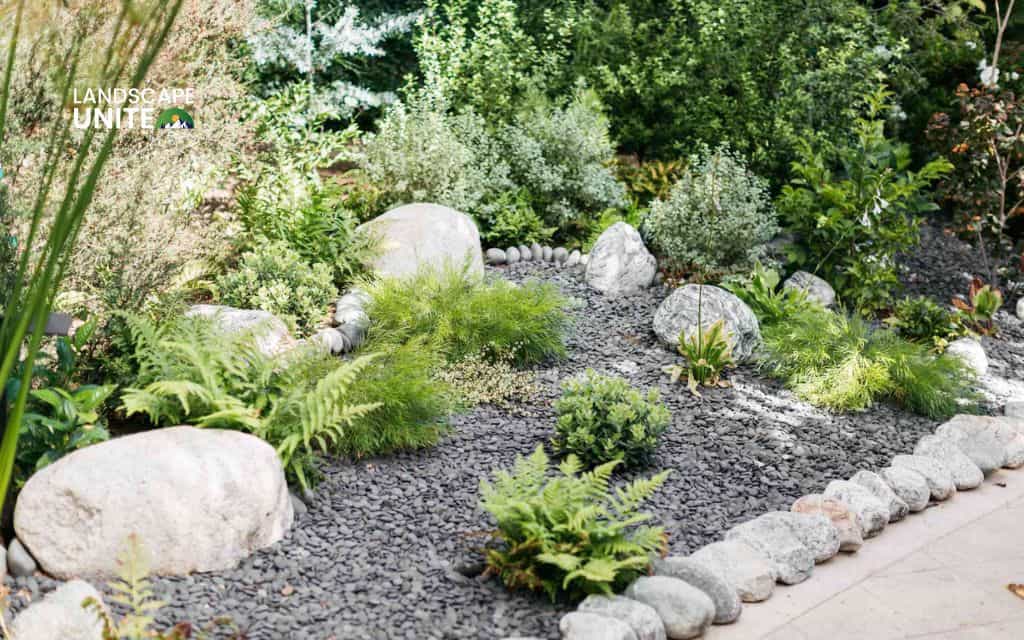
Circular raised rock bed
Create a focal point in the center of your yard or at garden intersections with circular raised rock flower beds. Design with taller plants in the center graduating to shorter varieties at the edges for layered color arrangements visible from all angles.
Circular beds work well with curved stone placement or cut blocks arranged in circular patterns. Diameter of 4 – 8 feet provides sufficient planting space while maintaining manageable scale.
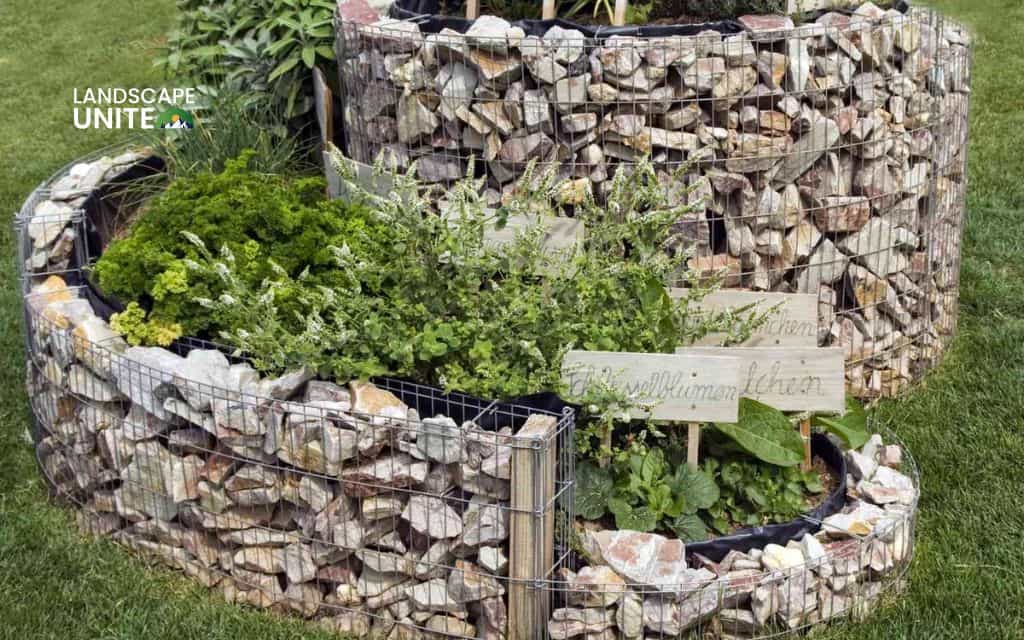
Terraced hillside rock beds
Transform sloped terrain into functional garden space by building multiple level raised rock flower beds. Each terrace creates a flat planting area and provides excellent erosion control.
Start at the bottom of the slope and work upward, ensuring each level is backfilled and drainage is directed away from walls. Plant each tier with different color schemes or plant types for cascading visual interest.
This approach turns challenging slopes into stunning vertical gardens while solving drainage and erosion problems.

Border rock beds along pathways
Frame walkways, driveways, or sidewalks with low rock edges filled with colorful perennials. These border beds define circulation paths while softening hardscape edges.
Choose plants that won’t overgrow onto walking surfaces or select varieties you’ll trim regularly. The raised edge prevents mulch and soil from washing onto pavement while creating pleasant visual boundaries.
Consider repeating plant patterns on both sides of pathways for cohesive symmetry.
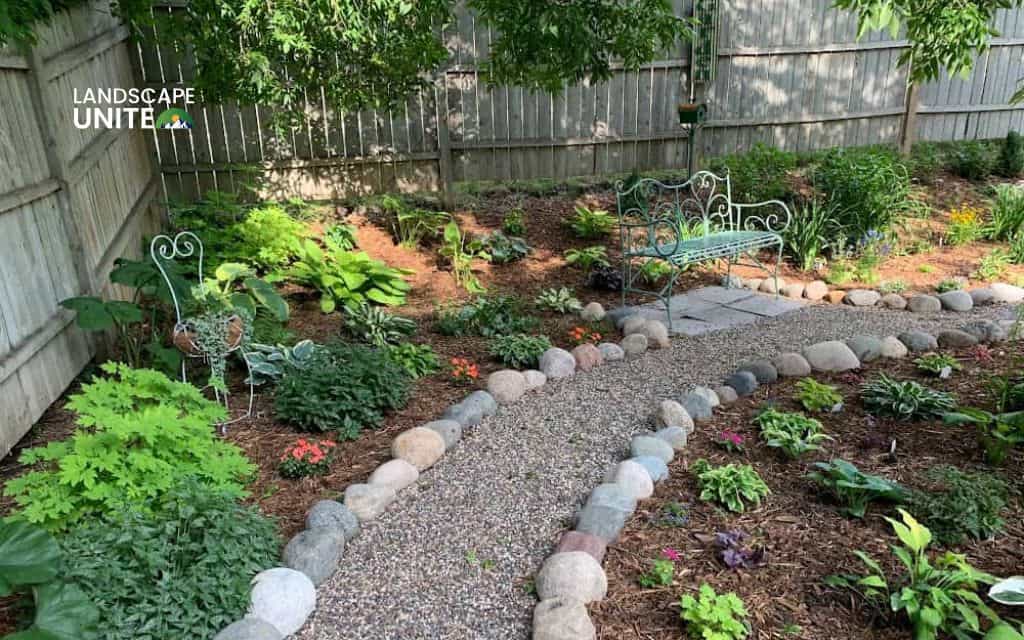
Herb garden in stone
Combine function and beauty with a compact stone herb bed placed near your kitchen door.
Mediterranean herbs like rosemary, thyme, oregano, sage, and lavender thrive in the excellent drainage and warmer soil temperatures raised rock flower beds provide.
The elevated position makes harvesting comfortable without bending, and the stone’s heat retention extends the growing season. A 3×6 foot bed provides ample space for a diverse herb collection.
The fragrance and culinary utility make this a rewarding project for food gardeners.
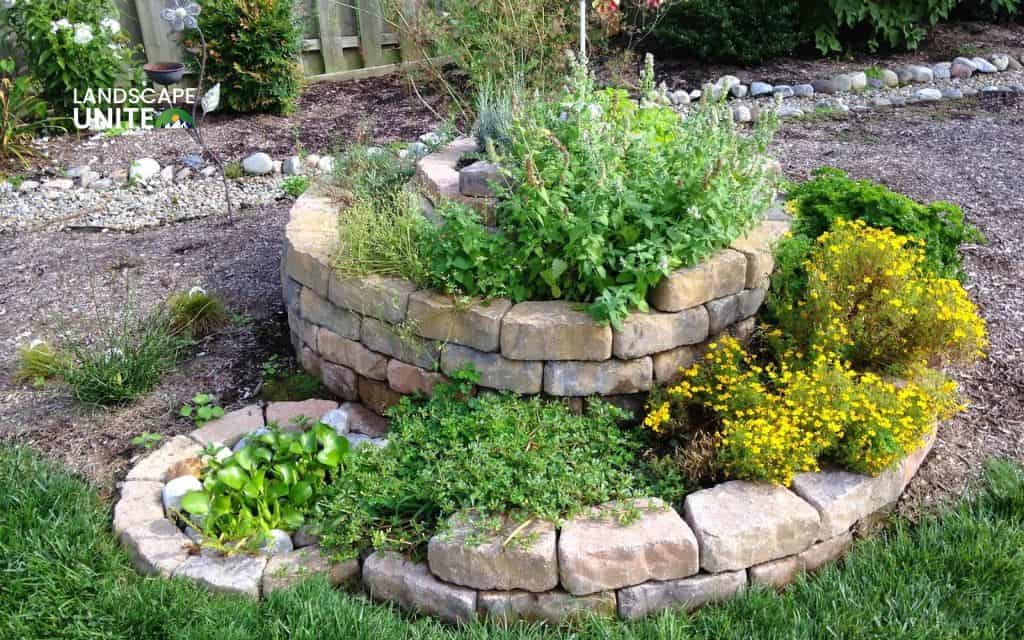
Rock and gravel combination bed
Mix small decorative pebbles between large structural stones for textural contrast and enhanced drainage. Use 3-6 inch stones for the bed walls, then fill gaps and surrounding surface areas with gravel in complementary colors.
This creates visual interest while preventing weed growth and maintaining excellent soil drainage. The varied textures catch light differently throughout the day, adding dynamic appeal.
This design works particularly well for xeriscape gardens and drought-tolerant plantings.
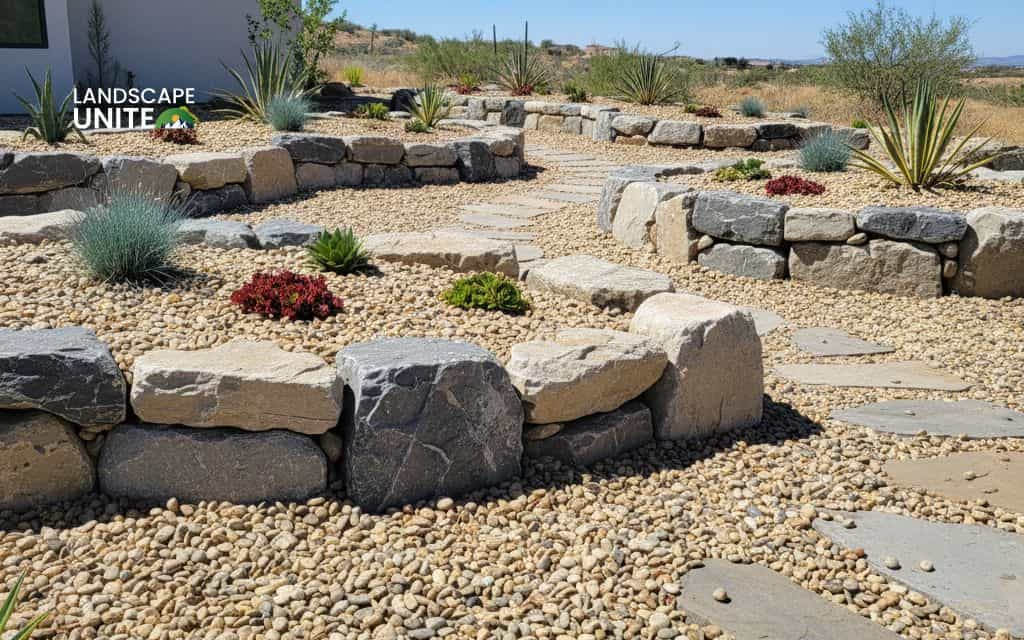
Raised rock bed with water feature
Integrate a small fountain, birdbath, or bubbling rock into one section of your raised rock flower bed for added tranquility and wildlife attraction. Position the water feature at one end of an elongated bed or as a centerpiece in a circular design.
The combination of flowing water, natural stone, and lush plantings creates a complete sensory experience. Water features attract beneficial birds and insects and provide soothing background sound.
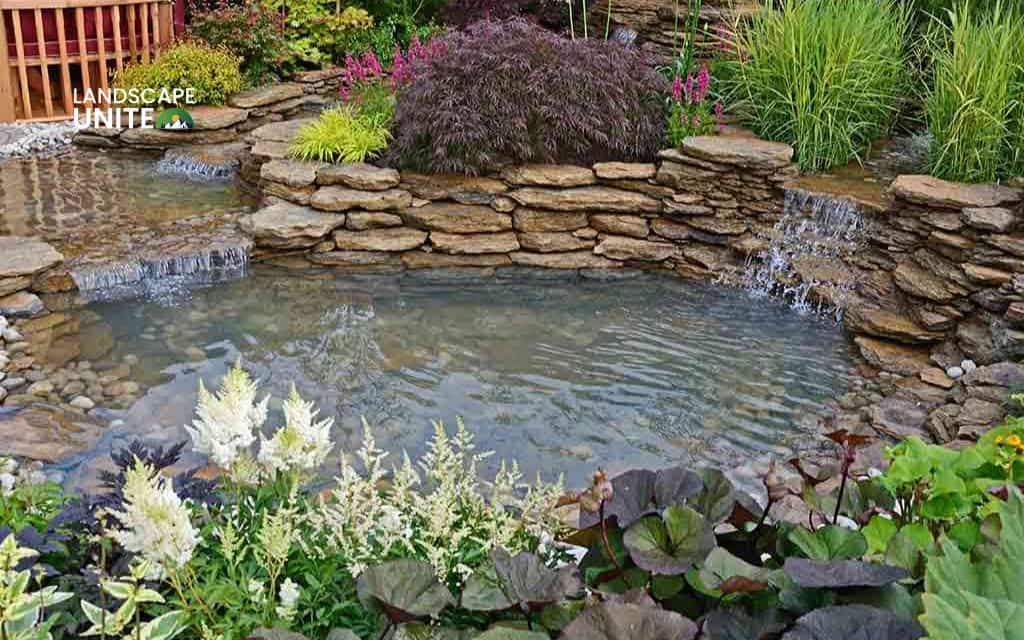
Corner rock bed
Maximize tight corner spaces by installing L-shaped raised rock flower beds. These beds add vertical interest to underutilized areas while eliminating awkward trimming spots.
Build 2 perpendicular walls meeting at a 90-degree angle, with heights ranging from 12-30 inches depending on available space.
Layer plants with taller varieties at the back corner graduating to shorter ground covers at the front. Corner beds effectively frame property boundaries and define outdoor spaces.

Multi-tiered stone bed
Create dramatic visual impact by building raised rock flower beds with multiple internal levels using different rock sizes and plant heights. Construct the outer wall at full height (24-36 inches), then add internal stone terraces at mid-levels.
Plant tall vertical accents in the highest tier, medium-height perennials in middle sections, and trailing or compact plants along the outer edge. This cascading design provides depth and allows sun-loving plants at upper levels and accommodates shade-tolerant varieties below.
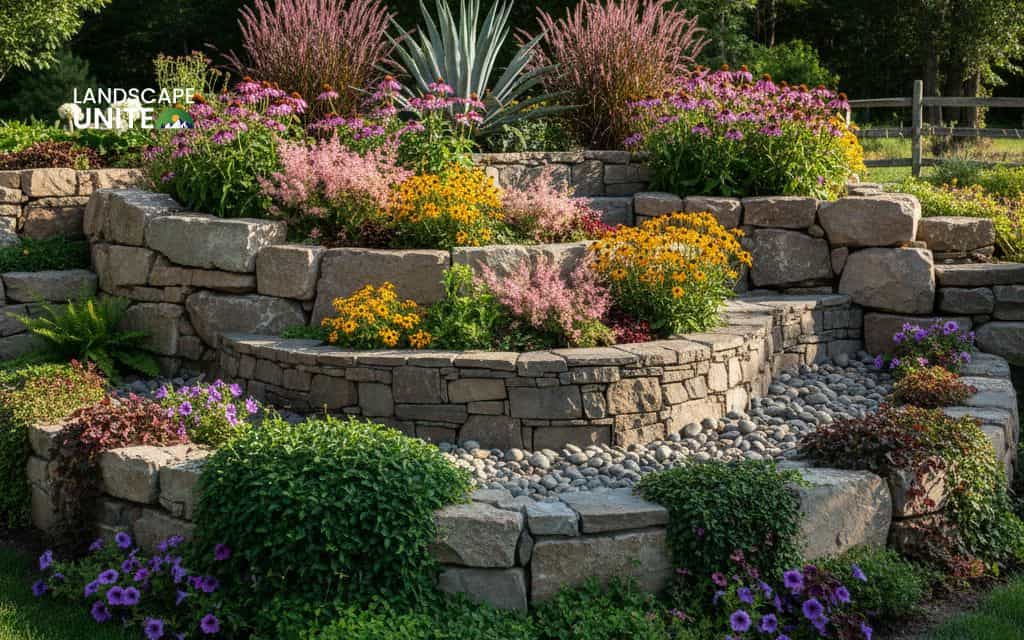
Recycled stone raised bed
Build an eco-friendly raised bed using leftover, salvaged, or repurposed rocks from other projects. Mix brick remnants, broken concrete pieces, and various stone types for eclectic character. This approach reduces project costs and diverts materials from landfills. Clean all materials thoroughly and test stability before finalizing your design.
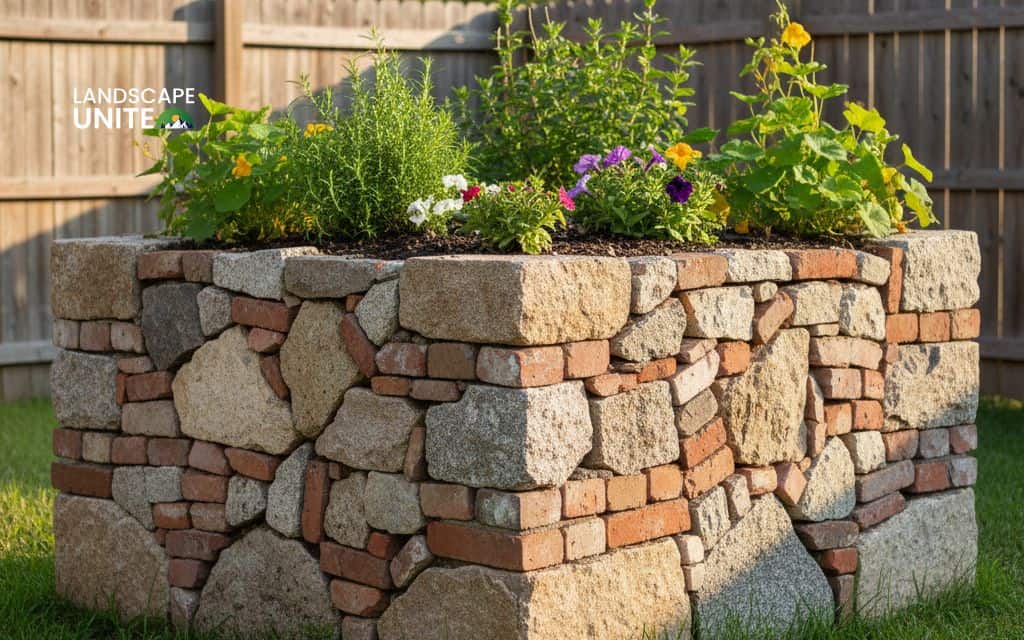
Dry-stacked rock bed
Embrace a natural, mortar-free design that allows water to flow through joints easily. Carefully select and position stones so weight and friction hold them in place without adhesives.
This traditional method works best for beds under 24 inches high with gently sloping or level terrain. The gaps between stones provide habitat for beneficial insects and allow plant colonization for aged character.
Dry-stacking offers flexibility for future modifications and easier seasonal adjustments.
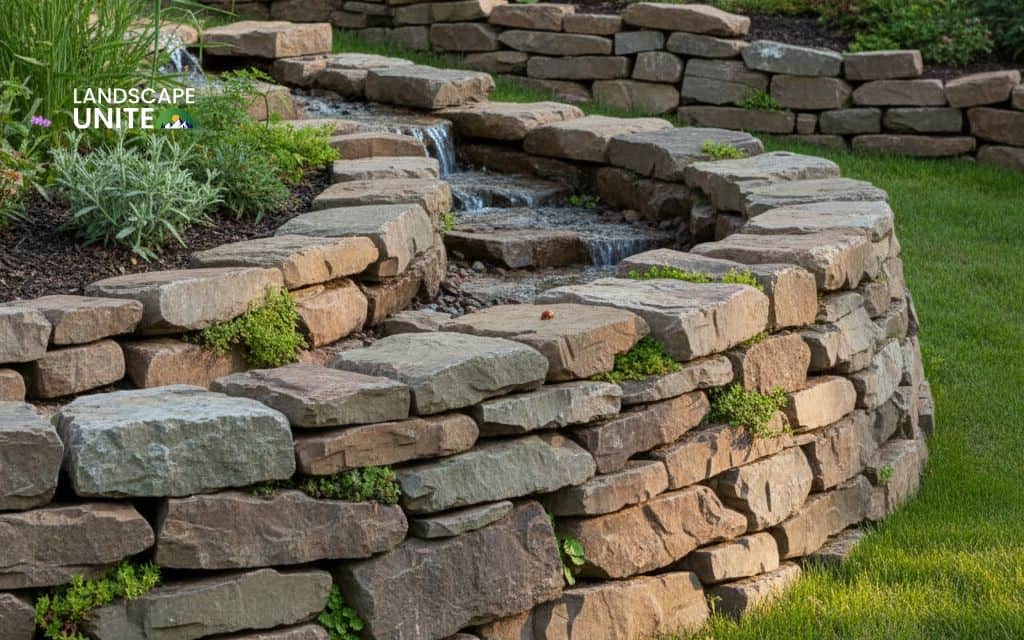
Flagstone-framed rose garden
Create an elegant focal point for front yards and patios with large flagstone pieces forming the raised bed walls. The flat, horizontal stone surfaces create natural seating edges perfect for admiring fragrant rose blooms.
Choose rose varieties suited to your zone, planting them in rich, well-amended soil. The flagstone’s neutral tones complement roses in any color while the raised position improves air circulation around plants, reducing disease pressure.
Beds 18-24 inches high provide ideal rose growing conditions.
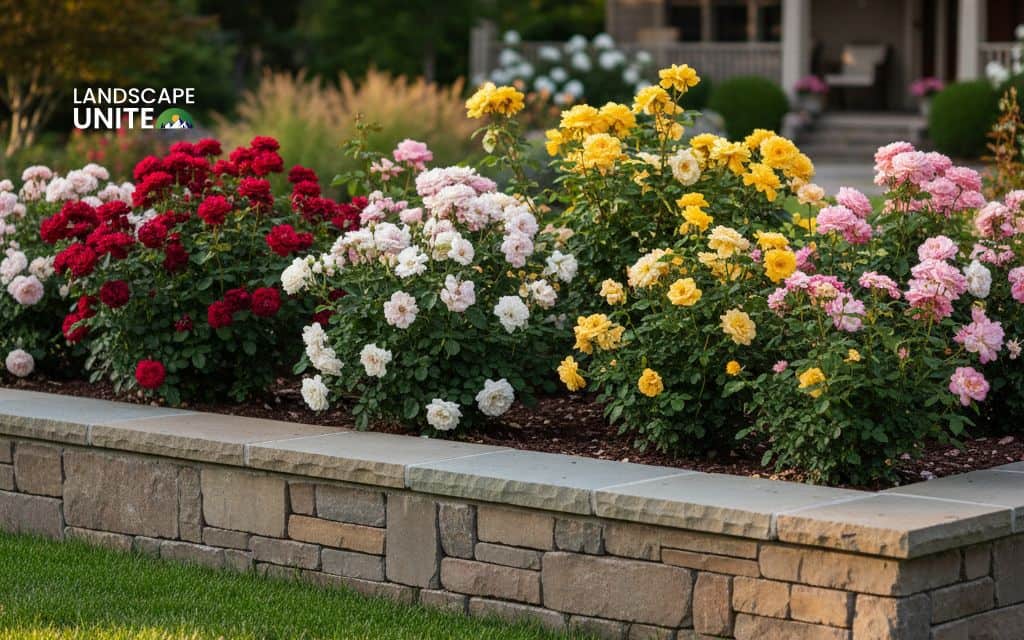
Desert-inspired rock bed
Use warm-toned stones in rust, tan, and amber shades combined with drought-tolerant succulents and cacti for southwestern style.
Arrange rocks in natural-looking formations mimicking desert landscapes, incorporating both large specimen stones and smaller fill material.
Plant agaves, yuccas, prickly pear, and colorful sedums between rocks. Add decomposed granite or golden gravel as mulch to complete the desert aesthetic. This low-maintenance design thrives in full sun with minimal irrigation once established.
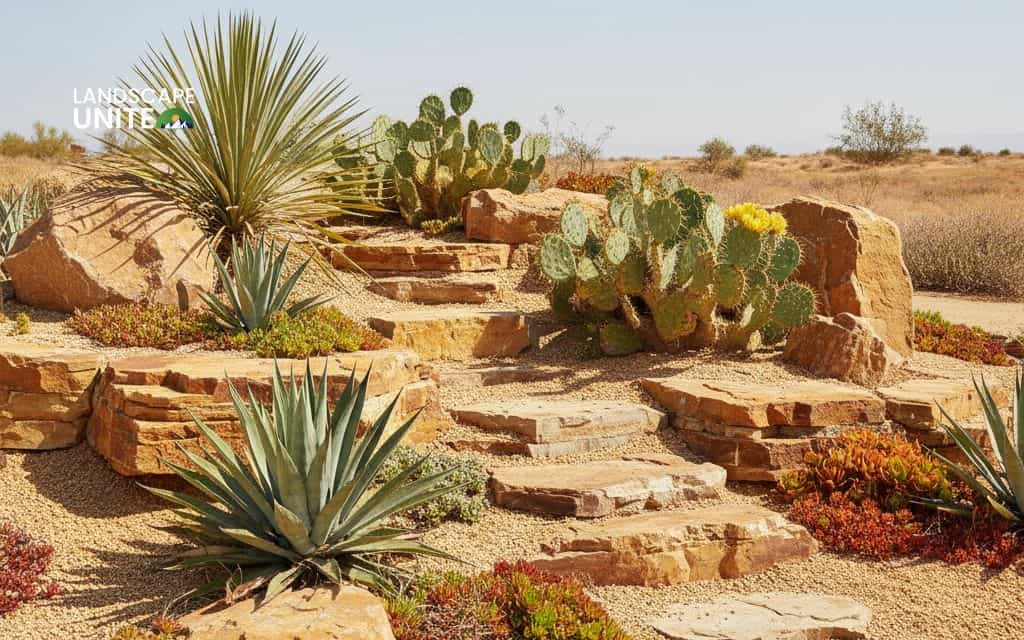
Conclusion
Raised rock flower beds offer beauty, function, and lasting value, turning ordinary landscapes into architectural showpieces. With improved drainage, natural aesthetics, and decades of durability, stone beds solve common gardening challenges while enhancing property appeal.
With the right design and materials matched to your climate and yard conditions, you can build a low-maintenance bed that’s uniquely yours. Whether you choose rustic fieldstone, sleek cut stone, or any creative variation we’ve explored, your raised rock flower bed will become a defining landscape feature you’ll enjoy for generations.
Explore our garden resources for more expert advice on stone selection, drainage solutions, and plant pairings perfect for elevated rock gardens.
Frequently asked questions (FAQs)
Are raised rock flower beds expensive to build?
Costs vary by rock type and size. DIY beds using local or recycled stone can cost $200 – $500 for a basic 4×8 foot bed, while premium materials may run $600 – $1,200. Professional installation adds $300 – $800. Using property stones or recycled materials reduces costs by 40-60%.
Do I need mortar for rock garden walls?
Not for walls under 2 feet tall. Dry-stacked beds are stable for lower heights when stones are carefully positioned. Taller structures above 24 inches or beds on slopes benefit from mortar for added stability.
Can I use any rocks I find on my property?
Yes, but clean and evaluate them first. Avoid soft, flaky, or crumbling stones. Harder stones like granite, limestone, and river rock perform best. Test by striking stones together – solid stones ring clearly while weak stones produce dull thuds.
What’s the best soil mix for raised rock beds?
A blend of topsoil, compost, and sand (2:1:1 ratio) ensures good drainage and nutrition. Adjust ratios based on plants: increase sand for succulents, add more compost for moisture-loving plants.
How long do stone raised beds last?
Properly built stone beds last 50+ years with minimal maintenance. Unlike wood (5-10 years) or metal (15-20 years), natural stone lasts indefinitely when correctly installed, making it highly cost-effective long-term.

